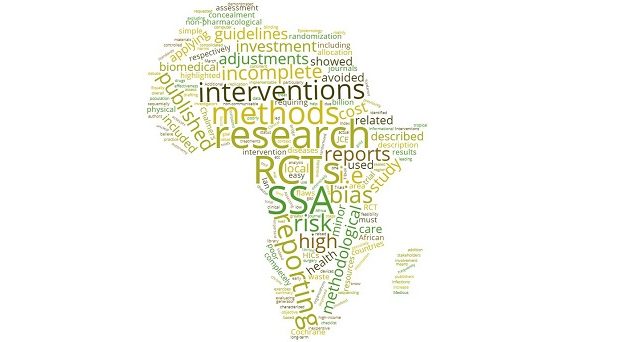
Sub-Saharan Africa (SSA) is defined as the region of the African continent excluding Maghreb countries. In that area extensively characterized by a burden of disease due to both tropical infections and chronic or non-communicable diseases, research is needed to improve health status of the local population.
In the context of biomedical research, randomized controlled trial (RCT) is the gold standard for evaluating the effectiveness or harms of health care interventions, including drugs or non-pharmacological treatments (surgery, implementable devices, physical exercises etc.).
However, we know that because of constrained resources, few RCTs are carried out in SSA compared to high-income countries (HICs).
In 2009, Ian Chalmers and colleagues showed that about 85% of biomedical research investment i.e., $200 billion of investment in 2010 was wasted.
In a previous study published in the Journal of Clinical Epidemiology (JCE), my colleagues and I showed that SSA RCTs focus on high burden diseases in SSA but are frequently funded and led by HICs. This study raised an important debate about the research autonomy of SSA and implied as a long-term goal, a greater involvement of local stakeholders and community organizations.
Furthermore, in 2009, Ian Chalmers and colleagues showed that about 85% of biomedical research investment i.e., $200 billion of investment in 2010 was wasted. This particularly occurred in methods for conducting research and from incomplete or unusable research reports.
In addition, Yordanov and colleagues demonstrated that most of the inadequate methods (i.e. those leading to a high risk of bias of flaws) could be corrected by applying easy methodological adjustments with no or only minor cost (i.e., ≤5% of the total cost of the trial).
I believe that waste of research related to inadequate methods or an incomplete reporting of SSA RCTs must be avoided because of the shortage of research resources in that area. This means that SSA RCTs should genuinely minimize risk of bias related to its inherent methods (i.e., randomization procedure, allocation concealment, blinding, and incomplete outcome assessment). Equally, reports interventions evaluated should be used in current clinical practice to bridge the gap with research.
Assessing inadequate methods and poor reporting of interventions
In our study published in Trials we performed a systematic review based on the sample of 121 SSA RCTs published from January 2014 to March 2015, and previously included in the JCE study. Our objective was to assess inadequate methods and how completely the health care interventions evaluated were described.
We identified reports of SSA RCTs through three databases including PubMed, the Cochrane library and the African Index Medicus. For the assessment of both methodological aspects, we respectively used the Cochrane risk of bias tool that assesses the risk of bias as being high, low or unclear; and the CONSORT guidelines (consolidated standards of reporting trials) or the TIDieR checklist (template for intervention description and replication).
The results highlighted that applying simple methodological adjustments with no or minor cost could have avoided a high risk of bias in 24 RCTs (19%).
The results highlighted that applying simple methodological adjustments with no or minor cost could have avoided a high risk of bias in 24 RCTs (19%). These adjustments included for example a computer random number generator, sequentially numbered opaque sealed envelopes, and an intention to treat analysis, respectively related the randomization and the allocation concealment procedures, as well as the incomplete outcome data.
About the interventions reporting, the most poorly described aspects mainly concerned non-pharmacological interventions and included the actual procedures involved or the sequencing of the technique, the physical or informational materials used, and the background of the care providers.
Additional information requested to authors of incomplete RCT reports overall improved the completeness of the intervention description from 60 to 69% (i.e. an avoidable waste of 9%). Interventions published in journals requiring adherence to the CONSORT guidelines were more completely described than those published in journals not requiring any one reporting guidelines (62% vs 51%).
In summary, to increase the value of SSA RCTs, we must help local investigators to be informed of the feasibility of easy and inexpensive methods and publishers to use reporting guidelines when planning their RCTs or drafting their reports. Indeed, this will limit flaws in methods and poor reporting of interventions at an early stage.
Comments